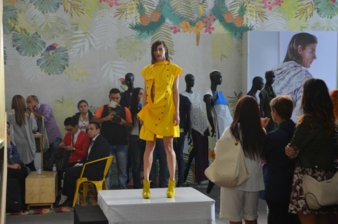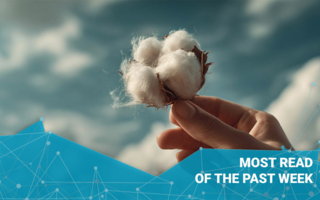16/03/2015 — auf Deutsch lesen
27th Colombiatex: Always on the up
With mild temperatures and high spirits, the Colombiatex de las Americas entered into its 27th edition from 27 to 29 January in Medellin. Around 26,000 visitors and almost 10,000 buyers were inspired by the vibrant mix of exhibitors, shows and presentations.
The organisers of Colombiatex de las Americas gave a positive review of the 27th edition of the show, one of the largest textiles trade shows in South America, which took place in the Colombian city of Medellin. “We are closing with anticipated business levels totalling USD 306m – this represents an increase of 15 percent compared to 2014,” said Carlos Eduardo Botero Hoyos, CEO of Inexmoda, who organises the show. With 500 companies in attendance, the number of exhibitors remained constant compared to the previous year despite uncertainties concerning trade agreements with Venezuela and Ecuador.
Within six halls, Colombiatex brought all areas of the textiles chain together, starting with textiles and clothing machinery, through fabrics and fabrics trends, to sewing accessories and the so-called “Full Package”. This year, Colombiatex was guided by the overall motto “Open Access” – a symbol of opening up the industry to new technologies, ideas and structures. In this way, the keynote speeches in the Knowledge Pavilion, which were organised as a collaboration between Inexmoda and the Pontifical Bolivarian University of Medellin, formed a central hub linking the research, industry and creative sectors.
The Trend Forum presented a representative sample of all the fabric trends at the exhibition, which were analysed and embedded in trend and colour sheets. In addition, Martha Cálad, Director of the Fashion Lab at Inexmoda, gave presentations on the subject of macrotrends, or as Cálad put it, the “overarching trends across all areas – social, political, economic and creative.” They are essential in finding out how fashion will continue to evolve, Cálad continued. “These are issues that people deal with in their everyday lives. Ultimately, fashion products need to satisfy people’s wants and needs.”
As an example for next winter, explained Cálad, the topics of globalisation and multiculturalism will be reflected in prints and materials – the Fashion Lab calls this macrotrend‘Metamorphosis’. For the second time, the Fash.Mob events served to build a bridge between exhibitors and end consumers. For half an hour at a time, the outside area was transformed five times into an innovative pop-up catwalk. Young designers presented their ideas and demonstrated how textiles can ultimately appear and be used in end products.
Clara Henriquez, Director of Commercial Platforms at Inexmoda, emphasised that: “We cannot distance the textiles industry from its raison d’être – the end consumer is always at the focus of business. We created the Fash.Mobs events in order to connect the industry with creativity and innovation.” From a German perspective, the strong focus on European designs at the shows and among the exhibited products was particularly striking. As Martha Cálad pointed out, the Colombian industry is looking to integrate itself within the global fashion industry, and therefore has little interest in specifically Colombian designs. Children’s clothing manufacturer Offcorss is also striving for European or American looks in its collections. Marketing Director Alejandra Munoz added: “We go to all of the major shows in Paris, London and Berlin and allow ourselves to be inspired. The Colombian influences can be most clearly seen in the use of vibrant colour.”
Despite the move towards European aesthetics, few companies are turning towards European markets in matters of trade. “Business has definitively bottomed out in recent years, primarily due to unfavourable exchange rates,” explained Clara Henriquez. However, as stressed by Vice Minister for Business Development Sardi Cruz, the falling value of the Colombian Peso provides excellent opportunities for domestic companies to open up new export markets. The language barrier is also a problem that is not to be underestimated. For this reason, Spain was by far the most highly represented European country with 38 exhibitors out of a total of 70 participating European companies.
The only German manufacturer, Martin Pliester from Wuppertal, was taking part in Colombiatex for the first time. Director Christian Escher gave a positive, but reserved review of the show. “The interest is certainly there, we had a lot of visitors and some fruitful discussions. However, we will see what becomes of them in the coming weeks. Fundamentally, and this is a general problem in South America, imports are simply not clearly regulated yet. The infrastructure is often not there, and some companies have confirmed to us that it is almost impossible without a location in Colombia. In this respect, our presence at the trade show is just a first attempt at exploring this market.”
And, as Escher pointed out, the atmosphere at Colombiatex is very unique and inspiring. Colombian helpfulness and friendliness make an impression on many of the international exhibitors and visitors. It is obvious that all those involved put in a lot of effort to present their city, Medellin, and Colombia in the best possible light. This is also reflected in the enormous political endeavours over the last few years to free Medellin from its image as a drugs capital. Above all, investments in the areas of local public transport and sustainable city development earned Medellin the distinction of “the most innovative city in the world” from the Urban Land Institute in 2013.
Particularly noteworthy are the modern metro network to link the rich and poor parts of the city in a quick and affordable way, the public libraries as well as the adventure parks in deprived areas. Nevertheless, the feeling of insecurity has still not been banished from the streets of Medellin. Taxi drivers warn people about dangerous areas, and it is generally unadvisable to carry electronic devices in the downtown part of the city.
The murder rate has risen accordingly in recent years. However, undeterred by these, Medellin is further committed to the development of the city and, according to the Regional Pact for Innovation, 1 percent of national GDP will be invested in the region around Medellin. The textiles industry plays a vital role in this as it employs around 30 percent of Medellin’s inhabitants and is one of South America’s strongest sectors overall – not least because of events such as Colombiatex and its sister event Colombiamoda, which will be taking place this year from 28 to 30 July, and is more heavily focused on fashion and design.
[Hannah Werner]
[colombiatex.inexmoda.org.co]
Sustainability in production is also becoming an increasingly important topic for the textiles industry in Colombia. Spanish company Jeanologia, specialising in resource-efficient laser technologies for jeans finishing, has noticed a change in consumer awareness. “We introduced our sustainable wash system three years ago.
A lot has changed since then – companies are increasingly prepared to make long-term investments in environmentally-friendly technologies,” explained Jesus Blay Andres, Area Manager at Jeanologia. “70 litres of water are required to wash a pair of jeans conventionally. Our process is based on nano-bubbles and requires just 5 litres of water.” However, as Blay Andres argues, sustainability alone is not enough of a selling point – ultimately, such investments must also pay off financially for the companies.
Colombian company Offcorss manufactures all of its products within Colombia. “Our environmentally-friendly company philosophy guides our decision-making. This is why we make special demands on our suppliers – such as lower water consumption or the avoidance of poisonous chemicals, for example,” explained Ana Maria Galeano, Head of Product Development at OFFCORSS. In Colombia, however, there are no laws or licensing procedures to certify or guarantee environmentally-friendly production.
“For us, it is a question of principle – but, of course, sustainable and clean manufacturing processes have increasingly become a selling point among our target demographic of young families.” It is also a key topic with regard to future cooperation with Europe, assures Galeano. For Offcorss, their presence at Colombiatex is vital to strengthen their connections and cooperation with suppliers, as “ultimately, the customer is buying a product that we have all invested in,” concluded Galeano.





